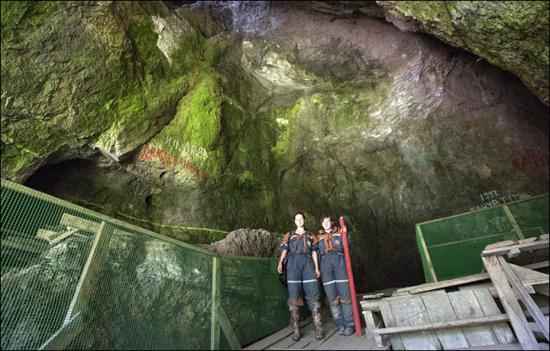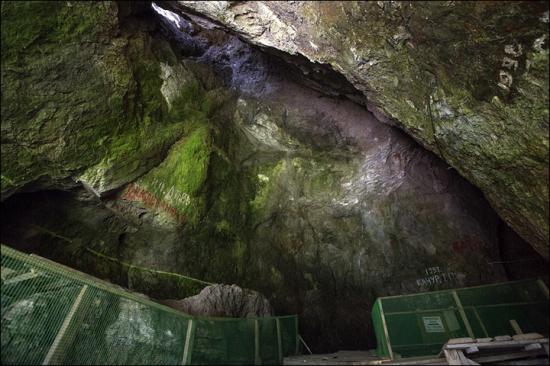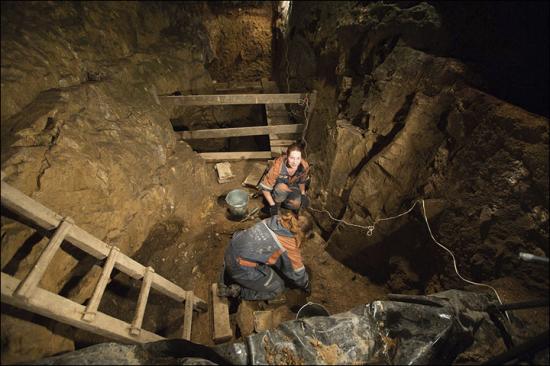Anna Liesowska
Source - http://siberiantimes.com/science/casestudy/features/f0135-first-glimpse-inside-the-siberian-cave-that-holds-the-key-to-mans-origins/
New revelations expected as Novosibirsk experts share latest ancient finds with world's leading specialists.
 The significance of the cave is immense, and the experts are convinced it has more secrets to give up on human origins. Picture: Vera Salnitskaya
The significance of the cave is immense, and the experts are convinced it has more secrets to give up on human origins. Picture: Vera Salnitskaya
These exclusive pictures show the world famous Denisova Cave in the Altai Mountains from which a series of stunning scientific discoveries on man's origins have been made in recent years.
More are expected as a result of a hive of archeological activity - overseen by the specialists from Novosibirsk State University - underway at this unique site inhabited continuously from the deep past.
Scientist Maksim Kozlikin said: 'We are working with Oxford University in the UK, they help us with radiocarbon and other dating and also conduct studies of ancient DNA. Currently, we continue cooperation and there can be new joint scientific articles.'
The significance of the cave is immense, and the experts are convinced it has more secrets to give up on human origins. Here in 2008 was discovered a finger bone fragment of 'X woman', a juvenile female who lived around 41,000 years ago, analysis of which indicated that she was genetically distinct from Neanderthals and modern humans.
This previously unknown and long extinct hominin species or subspecies was christened Denisovan after this cave. In 2010 analysis on an upper molar from a young adult, found in the cave ten years previously, was also from a Denisovan.
In 2011, a toe bone contemporary with the finger was found with the mitochondrial DNA suggesting it belonged to a Neanderthal, not a Denisovan. Tools from modern man have been found in the cave, too.
As scientist Svante Paabo, from the Max Planck Institute for Evolutionary Anthropology in Leipzig, Germany, said: 'The one place where we are sure all three human forms have lived at one time or another is here in Denisova Cave.'
Another significant find in 2008 - in the same layer as the Denisovan bone - was a stone bracelet dated 40,000 years old, but it was made using the technologies specific to a much later time.
It was due to this cave that scientists understood the settlement of this part of Siberia went back longer than the assumed 30,000 to 50,000 years. Traces in the 'cultural layer' of the Denisova show the human habitat reaching back 282,000 years. So far it has given up more than 80 000 exhibits including implements, arms, ornaments, and the remains of animals and plants.
 'At this very place, where the cave is located, is in fact a canyon, because the width of the bottom of the valley here is less than the distance between two major peaks - Mount Karakol and Mount Sosnovaya. Vera Salnitskaya
'At this very place, where the cave is located, is in fact a canyon, because the width of the bottom of the valley here is less than the distance between two major peaks - Mount Karakol and Mount Sosnovaya. Vera Salnitskaya
The Denisova Cave is located in the Bashelaksky Range of the north-western Altai Mountains, close to the border of today's Altai Region and the Altai Republic, but in ancient times it would have been an attractive location.
The cave is at an altitude of 670 meters above sea level, and at 28 meters above the present level of the Anui River.
Kozlikin, a research fellow of Institute of Archaeology and Ethnography, part of the the Siberian Branch of the Russian Academy of Sciences, explained: 'From the ancient hunter's point of view the location of Denisova Cave was very convenient. To the north of the cave stretches a rather wide valley, and there is another to the south.
'At this very place, where the cave is located, is in fact a canyon, because the width of the bottom of the valley here is less than the distance between two major peaks - Mount Karakol and Mount Sosnovaya. So Denisova Cave is in a rather narrow canyon. Through this canyon - as if through a bottle neck - migrated the animals, from one valley to another. So the ancient hunter always had enough prey. There is a water nearby and good climatic conditions of the mountainous valleys.'
In the late Pleistocene era, some 100,000 years ago, an ice sheet covered much of western Siberia, but not Altai valleys such as this. 'So it was a good place for hunting and gathering plants too, and very comfortable conditions for the humans and animals.'
Indeed, there are other signs this was a hive of activity in ancient times.
A few kilometres down the Anui River is located Paleolithic site Anui-2 and four kilometres up the river is Karakol site and others, so there are quite a lot of Paleolithic sites on this area, around the cave.
'During the excavations, we found that the most ancient - 22nd - layer of Denisova Cave is 'sterile', in other words, there are no remains, or sediments.
'It turned out that 300,000 years ago Anui River had another bed, which was located higher, very close to the entrance of the cave. As soon as its course became lower, ancient humans and animals begin to visit the cave. On the upper part of the 22nd layer were found implements and the remains of animals. This happened around 282,000 years ago.
'At this time, the climate here was rather mild. Oak grew here, along with hornbeam, Manchurian walnut and even the northern species of bamboo. We see here the remains of European ass, bison, woolly rhino, several species of deer, elk, cave lion, cave hyena, bear, and snow leopard.

 The wall, showing all the 22 layers of Denisova cave. Green line marks the level covered with sediments before the excavation. Pictures: Vera Salnitskaya
The wall, showing all the 22 layers of Denisova cave. Green line marks the level covered with sediments before the excavation. Pictures: Vera Salnitskaya
Before the excavations, there was only a rather narrow manhole to the cave, because sediments covered it. The width of a manhole was about 1.4 metres. The cave was known to locals and some even left the inscriptions at the entrance at the beginning of the 20th century. Still they did not venture further in simply because there was not so much space inside.
In 1977 famous paleontologist Nikolay Ovodov made a pit in the central part of the cave and found a lot of paleontological material and stone implements. He shared with his findings with archaeologists and in 1978 Alexey Okladnikov came here.
'Since 1984, archaeological expeditions work here every summer. In late 1980s and early 1990 here was built a permanent archaeological camp - houses and other facilities. So for more than 30 years there have been archaeological works are conducted here. Still the huge part of the cave is not explored yet, even the central hall.'
Work can go on here for many years, with the prospect of major new discoveries.
Giving us a tour of the cave, Kozlikin said: 'On the right the central hall adjoins the southern gallery, which is about 20 metres wide and it is almost fully covered with unexplored sediment. Now the work is being done in the eastern gallery, next to the central hall.
 'We divided the area into squares with the size 1x1 metre. Each square we subdivided into two parts. Over there you see that these girls sitting and carefully removing all the ground from the square, layer by layer.
'We divided the area into squares with the size 1x1 metre. Each square we subdivided into two parts. Over there you see that these girls sitting and carefully removing all the ground from the square, layer by layer.
'In this eastern gallery we have already finished the famous 11th layer, which brought us the Denisovan's finger bone, bracelet and a necklace of elk teeth. Now we went deeper and are working with the 12th, 13th, and 14th layer - Middle Paleolithic. The 14th layer is dated about 180,000 years ago. Here we have typical Middle Paleolithic stone implements.'
PART.2